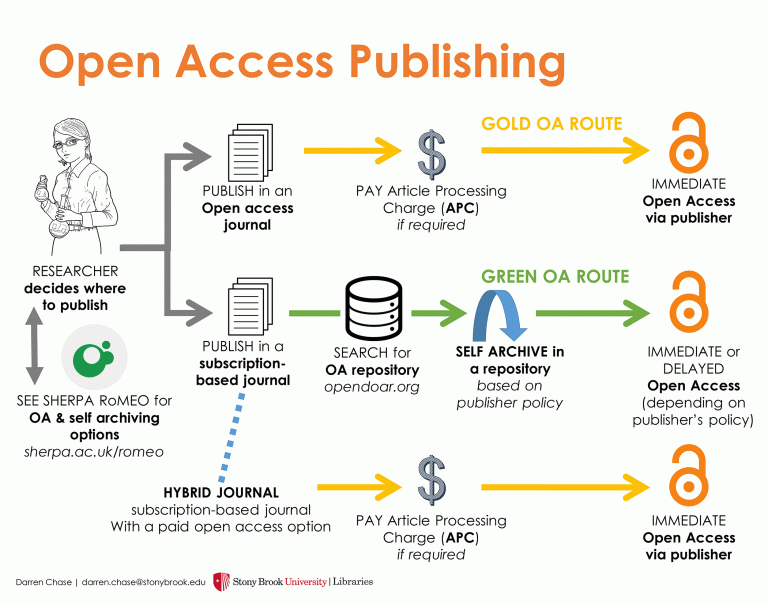OA Basics
What is Open Access?
Open access is a term used to describe alternative forms of academic publishing that are "open", as well as a term used to describe the movement advancing such forms of publishing. Open access publishing is where content is:
- Available online
- Free to access
- Has minimal or no usage restrictions
Types of Open Access
While there are many different forms of OA publishing, the two that are most commonly used and referred to are green and gold OA. Gold OA is when an article is made freely available online, immediately, in an academic journal. Green OA is when a version of an article (such as a preprint) is made available in a repository (like the UA Campus Repository), often after an embargo period following its publication in a paywalled journal. Note that while some Gold OA publications require an author processing charge (in which the author pays a fee to offset the cost of publishing the article), many OA journals do not require an APC.

Benefits of Open Access
Open access publishing has many benefits, for authors, researchers, and society. Some of these include:
- Increased research exposure (especially for students and early career researchers)
- OA articles have higher citation rates, on average, than non-OA articles
- Accelerated pace of research discoveries
- More public interaction with research
- Research has more value for and support from taxpayers
Myths About Open Access
Myth: OA publishers have lower quality than traditional publishers.
Research has found that OA journals have comparable methodological and reporting standards as non-OA journals (Pastorino et al 2016). In fact many traditional, prestigious journals now have open access publishing options.
Myth: All OA publishers charge author processing fees.
While some publishers charge steep APC fees, 71% of OA journals do not charge an author processing charge (Crawford 2016).
Myth: OA journals have poor impact factors.
In reality, the IFs of OA journals are steadily approaching the IFs of subscription journals (Bjork and Solomon 2012).
Learn More
- Copyright LibGuideTo learn more about copyright and its role in academic publishing, see this LibGuide.
- Predatory Publishers LibGuideTo learn more about the difference between OA and predatory publishing, and how to avoid submitting to predatory publishers, see this LibGuide.
The foundations of Open Access were defined by:
- Budapest Open Access Initiative (February 2002)
- Bethesda Statement on Open Access Publishing (June 2003)
- Berlin Declaration on Open Access to Knowledge in the Sciences and Humanities (October 2003)
Books on Open Access
Understanding Open Access by Understanding Open Access provides a scholarly author-oriented look at the ins and outs of open access publishing. The guide addresses common concerns about what "open access" means, how institutional open access requirements work, and why authors might consider making their work openly accessible online. Our aim is to provide real-life strategies and tools that authors can use to work with publishers, institutions, and funders to make their works available on the terms most consistent with their dissemination goals. Like all Authors Alliance materials and guides, Understanding Open Access is available on an open access basis and can be downloaded for free from authorsalliance.org/oa.
ISBN: 0692587241Publication Date: 2015-11-23Knowledge Unbound by Influential writings make the case for open access to research, explore its implications, and document the early struggles and successes of the open access movement. Peter Suber has been a leading advocate for open access since 2001 and has worked full time on issues of open access since 2003. As a professor of philosophy during the early days of the internet, he realized its power and potential as a medium for scholarship. As he writes now, "it was like an asteroid crash, fundamentally changing the environment, challenging dinosaurs to adapt, and challenging all of us to figure out whether we were dinosaurs." When Suber began putting his writings and course materials online for anyone to use for any purpose, he soon experienced the benefits of that wider exposure. In 2001, he started a newsletter--the Free Online Scholarship Newsletter, which later became the SPARC Open Access Newsletter--in which he explored the implications of open access for research and scholarship. This book offers a selection of some of Suber's most significant and influential writings on open access from 2002 to 2010. In these texts, Suber makes the case for open access to research; answers common questions, objections, and misunderstandings; analyzes policy issues; and documents the growth and evolution of open access during its most critical early decade.
ISBN: 9780262029902Publication Date: 2016-03-25Open Access by A concise introduction to the basics of open access, describing what it is (and isn't) and showing that it is easy, fast, inexpensive, legal, and beneficial. The Internet lets us share perfect copies of our work with a worldwide audience at virtually no cost. We take advantage of this revolutionary opportunity when we make our work "open access": digital, online, free of charge, and free of most copyright and licensing restrictions. Open access is made possible by the Internet and copyright-holder consent, and many authors, musicians, filmmakers, and other creators who depend on royalties are understandably unwilling to give their consent. But for 350 years, scholars have written peer-reviewed journal articles for impact, not for money, and are free to consent to open access without losing revenue. In this concise introduction, Peter Suber tells us what open access is and isn't, how it benefits authors and readers of research, how we pay for it, how it avoids copyright problems, how it has moved from the periphery to the mainstream, and what its future may hold. Distilling a decade of Suber's influential writing and thinking about open access, this is the indispensable book on the subject for researchers, librarians, administrators, funders, publishers, and policy makers.
ISBN: 9780262517638Publication Date: 2012-07-20
